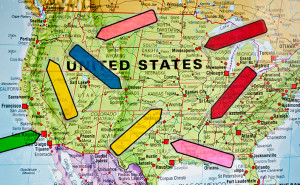It’s the number one question I hear from those who are new to selling via Amazon FBA: Why is Amazon forcing me to send my inventory to multiple warehouses all over the country? It’s expensive, inconvenient, and it’s cutting into my profit margins. What can I do to fix this?
In a perfect world, Amazon sellers would be able to take all of the items they are selling, send them to a single FBA warehouse, and continue to see those items sell quickly. Unfortunately, we don’t live in a perfect world. Amazon has their reasons for shipping our inventory to multiple fulfillment centers, so it’s important for us to understand why Amazon wants to do this.
As you probably know by now, Amazon is the most customer-centric company ever. Everything Amazon does is to make the customer happy. In relation to inventory, Amazon wants to have as many items spread out across the United States as possible. The closer an item is to the buyer, the faster that item can get there, which helps secure a happy customer. If you have a toy to sell, and Amazon already has that toy in stock in Florida, Dallas, Tennessee, and Colorado, then maybe they’ll have you ship your toy to California, where that toy is currently out of stock. When a customer in California wants that specific toy, and that toy is priced competitively, then you have a great chance of winning the buy box and getting the sale.
 Understanding why Amazon splits up your inventory doesn’t always make split shipments any easier. It can be frustrating when the bulk of your inventory is going to Indiana, yet one item needs to go to Tennessee, two items need to go to Texas, and another item to Arizona. For many of us, the cost of sending just one or two items to a separate FBA warehouse can completely destroy our profit margins.
Understanding why Amazon splits up your inventory doesn’t always make split shipments any easier. It can be frustrating when the bulk of your inventory is going to Indiana, yet one item needs to go to Tennessee, two items need to go to Texas, and another item to Arizona. For many of us, the cost of sending just one or two items to a separate FBA warehouse can completely destroy our profit margins.
So what is a FBA seller to do? Well, you have two options: Distributed Inventory Placement or Inventory Placement Service. Distributed Inventory Placement is where you let Amazon pick where it thinks your inventory should be shipped to. This is the default for those who sell via Amazon FBA.
 The other option you have is called Inventory Placement Service (Click here for Amazon’s page outlining inventory placement options). Choosing Inventory Placement will generally create one shipment for most of your standard sized inventory. I say generally, because Amazon actually only promises that they will send all quantities of a single MSKU to a single FBA warehouse. They do not promise that all items in your shipment will be sent to the same warehouse, but more often than not, they will. There are exceptions, such as oversized items, clothes, shoes, and some media (books, DVDs, etc), which will still need to be sent to a specific warehouse other than the main one you usually send inventory to. The inventory placement fee is currently 30 to 40 cents for each standard-sized unit and $1.30 for each oversized item. Click here to see the current fee structure. Remember, this fee is paid for every item that you are sending in to Amazon, not just on the multiples that might get split up if you did not have Inventory Placement turned on.
The other option you have is called Inventory Placement Service (Click here for Amazon’s page outlining inventory placement options). Choosing Inventory Placement will generally create one shipment for most of your standard sized inventory. I say generally, because Amazon actually only promises that they will send all quantities of a single MSKU to a single FBA warehouse. They do not promise that all items in your shipment will be sent to the same warehouse, but more often than not, they will. There are exceptions, such as oversized items, clothes, shoes, and some media (books, DVDs, etc), which will still need to be sent to a specific warehouse other than the main one you usually send inventory to. The inventory placement fee is currently 30 to 40 cents for each standard-sized unit and $1.30 for each oversized item. Click here to see the current fee structure. Remember, this fee is paid for every item that you are sending in to Amazon, not just on the multiples that might get split up if you did not have Inventory Placement turned on.
Here’s how to turn Inventory Placement Service on (or off):
1. Log in to Seller Central 2. Go to “Settings” and click “Fulfillment by Amazon.” 3. Click “Edit” in the Inbound Setting box. 4. In the “Inventory Placement” section, choose your preferred option (The default is Distributed Inventory Placement) 5. Click “update.”Before you head on over to Amazon to update your inventory placement settings, it’s a good idea to weigh the positives with the negatives of Inventory Placement Service.
1. Multiples of the same MSKU will not be split into different shipments and will all go to the same warehouse.
2. No more shipments of a single item to a different warehouse.
3. Your inventory will most likely be shipped to one of the warehouses close to you. This could mean lower shipping costs and less time your shipments are in transit.
4. Since your inventory will most likely be shipped to a nearby warehouse, you’ll get faster processing times, and your inventory could go live much quicker. The faster your inventory is processed, the faster it can be sold.
Negatives:
1. The cost of 30 to 40 cents per standard sized item could add up quickly and eat into your profit margins. If you have a shipment of 100 items, that could cost you $30-$40 in Inventory Placement fees alone. If you’re shipping in oversized items or items over 2 pounds, then the fees could be even higher.
2. Inventory placement doesn’t promise that all items in a shipment will go to the same warehouse, it only promises that multiples of the same item (MSKU) will not be split into multiple warehouses. So, you still may have to send items to three different FBA warehouses.
3. Here is a little known secret: Amazon ships your inventory to different warehouses without you even knowing it. You might have shipped your inventory to Tennessee, but after it’s processed, it could easily be removed and sent to Florida. While Amazon is shipping your item to Florida it’s usually considered “inactive” and cannot be sold. Now, there are rare times when Amazon will still try to still sell your item as “back-ordered” to their customer during its transit time, but this is not very common. Basically, I believe that Amazon takes the money it makes from the Inventory Placement Fees and uses that money to reallocate your inventory across the country.
Most Amazon FBA sellers don’t like shipping their inventory to so many warehouses, but it’s up to you to decide whether it’s worth it to pay the Inventory Placement Fees or not. I, personally do not. The fact that Amazon will temporarily deactivate some of my inventory while it moves those items across the country is a deal breaker for me.
To read more about Amazon split shipments and our strategy for how to minimize shipping costs and FBA fees, click here.
So what about you? Do you use Inventory Placement Service? If so, what do you like or dislike about it? Let us know if you have any questions about these options.
![]()
Imagine knowing exactly what to expect in your Amazon FBA business every month of the year.
Imagine what it would feel like knowing you were not missing out on any of the opportunities that will come your way this year. 
Imagine working on your Amazon business knowing exactly what your priorities are, what you need to avoid, and what you need to accomplish during each month to make progress toward making this year your best sales year ever.
Find out more about The Reseller’s Guide to a Year in FBA: A Month by Month Guide to a Profitable Amazon Business today. The package includes a 220-page ebook, monthly training videos, and 4 special bonuses.


I just started trying to send small orders of slow moving product to one warehouse since I can wait for it to sell. Super hot items are most likey going to MF if I think the price will tank, but if I have a good size shipment, then I will let them place it wherever that choose.
Good plan, Jason.
Stephen do you do any MF or strictly FBA?
99% FBA and 1% MF.
I was extremely frustrated with this when I started selling on Amazon a year ago. I bite the bullet and use Inventory Placement so I can pack and ship 1 full box at a time and get it done quickly. I don’t have the space or the patience to have 3 or 4 boxes partially full at any one time. The only time I really regretted it was in December when I got hit with a $350 Inventory Placement fee because I shipped so much into Amazon in November. Amazon has also recently switched to charging that fee by the box about 30 days after you ship a box as opposed to the big lump sum fee once per month. That seems to make it easier to take rather than seeing the big fee one time each month. Also, you can skirt around the fee sometimes if you wait until the very end of the shipping workflow to add the actual quantity of the item. I find this strategy works well if you are shipping say 7 Oversize items in 1 box and that’s all that’s going to be in the box. So I’ll approve the shipment with just 1 item and then modify the quantity at the very end. With this strategy you do have to turn off the Inventory Placement in your settings and then turn it back on again to do other boxes with a variety of items in them.
There’s my 2 cents!
Dave
RockSolidDeelz
Great article and explanation, I will refer our members to it for sure, very well done.
We simply don’t send single items. We try to do at least 30 – 40 items per plan. Today we had 43 items. 19 went to Ky, 7 Items to Nevada, 16 to Indiana, and they wanted us to send 1 item to California. We sent 3 and deleted the shipment to California, and will add the item to tomorrow’s shipment.
Thanks again for the the very informative article.
In November 2015 I received an Alert titled Deleted Shipments from Amazon that was tucked away under “View/Manage Case Log” and remained unseen until January 2016. Here’s a portion of the message:
“Shipping Plans PLN6CCWQ4,PLN6B9C7X and PLN6469CT had shipments within them that were improperly deleted. Continuing to improperly delete shipments will result in a suspension of your shipment creation abilities.”
“Once Amazon receives any shipment within a plan, we expect all other shipments in that plan to be received at the correct fulfillment center within 7 days.”
From the beginning of my transition to FBA, I am trouble with the exact situation you described and often delete a shipment within a plan and hold it until I have more inventory to send in hoping to fill a box. This Alert remained unseen for months, I never opened a Case so I was oblivious to Amazon responding and creating one to Alert me of anything. I sent a reply this month explaining I am now aware and any shipping plans from here on will meet requirements. Thankfully I’m still in FBA business with 2 months of deleted shipments worth after the alert was sent.
I do have an alternative suggestion. If you want to delete the one California bound item, Create a duplicate plan then delete the item from the list of inventory to be sent, click on create shipment, and 95% of the time (in my experience ) the multiple shipments and exact inventory are created minus the one item originally created for California.
Terry
I have noticed that some of my FBA items that were sent to one warehouse were shipped from a completely different warehouse. I wonder how this works when you send, let’s say, a book to a Arizona warehouse, but your books ends up being shipped from a warehouse in Kentucky? I don’t have a Nexus with Kentucky and am not signed up with that state to collect sales tax. So who does the tax go to? AND in many cases you would never know where it shipped from, so how in the world would you keep track of who owes who?
Jim,
The process that Amazon uses to move our inventory across the country is very troubling for when it comes to taxes. I would assume that as long as you are doing your best to collect sales tax in the states you are registered for, then a few sales in states where you are not set up to collect would not be that big of a deal. I don’t think that those situations would create a red flag in the eyes of those who regulate taxation. Just do your best, and I bet you’ll be fine.
Disclaimer: I am not a tax attorney and I am not giving out tax advise. Please do your own due-dilagence when it comes to what you do in all aspects of your business, especially taxes.
In my experience, #3 (Positives) never happens. The closest I can get to any warehouse near me is if I use the Distributed Placement, then Amazon will likely have me ship 1 of the 3 boxes to a warehouse in the neighboring state. It is my belief that I will never ever see a shipment going to the warehouse closest to me, which is one county over. I live on the West Coast, and even though I may pay extra for the convenience of having items sent to a single FC, Amazon still wants the item centrally located to buyers, which means I still have to ship halfway across the country.
I’m sorry, Phebe. I’m sure that’s frustrating. I hope you find the best solution that works for you.
Thanks Stephen for the breakdown, don’t wan’t to overthink on this, looks like the default settings may be better for those who are not sure and probably cheaper for dozens in the long run and active inventory without waiting.
I think the default settings are best to start off with.. and then do the math on each shipment to see if it’s worth it to you to do it with IPS the next time.
Thanks for the info. I have notice many different shipment different places. And the boxes were half full in some. It is frustrating.
Good info thanks again.
Glad I could be of help!
How can i know whether a FBA shipment ID is under Inventory Placement Services (IPS) or Distributed Inventory Placement (DIP) after creating them? I have few people that create FBA Shipment. They will change the setting between (IPS) and (DIP) upon creating the FBA shipment. Anyone know whether Amazon indication of IPS or DIP of a particular shipment plan / ID on the system? Thank you.
I’m not sure if you can tell after a shipment has been created if it’s DIP or IPS. The person who created the shipment would need to remember and communicate what kind of shipment it is. You could also just figure it out as you go… as you list multiple items, if they are not separated into different fulfillment centers, then IPS is turned on. If anyone knows another way to find out, please comment and let everyone know.
I have a different motus operandi which has worked well for me, so far…
When I wind up with what I call stragglers (items Amazon wants me to ship to warehouses which are unacceptably distant), I set them aside without labeling them. When I’m all done, I delete the listings for and the shipments containing the stragglers and set them on the shelf for a few days.
I have noticed that this usually (tho not always) occurs on Sundays in the late evenings. So I leave the stragglers sit until about Wednesday and then relist them. Almost always, Amazon sends me a more acceptable ship to warehouse and I wander off merrily on my way (so to speak).
I live right in the center of the Midwest USA and most any warehouse east of the Mississippi, other than Florida is OK by me. This may work very differently in other areas, but so far it has limited my shipments to one (usually) or sometimes 2 different warehouses at a time with minimal hassle.
Rick
That’s a good idea! Thanks for the tip.
If I have a few items going to one place and it is only one to three items, I will increase the amount by the 5% allowed. As an example, 3 items will allow you to increase the number to 9. It has been working well so far.
Sounds good, Randie!
We give you the option to ship all units of a given product to one fulfillment center for Amazon to distribute throughout the network for a fee. You are still required to send certain types of products to specific fulfillment centers, but you would not have to split shipments at the unit level.
When we started shipping to FBA years ago, we would get several shipments to several warehouses. Inventory was checked in and available typically within about 24hrs of receipt. After about two months of ramping up our volume to a few hundred units per shipment (4-5 ASINs), all of the sudden our shipping plans started directing everything to FTW1, with the exception of oversized items. Items would be checked in (more often than not incorrectly), then immediately deactivated and redistributed by AZ to other warehouses. While I appreciated making single large shipments, I was annoyed that our asset turns suffered and went from 3/mo to 1/mo. AZ did this on their own – we did not at any point elect for distributed placement.
Flash forward to this year, where we’ve swapped out product lines and are again ‘ramping up’. Our initial shipments were all over the place for about a month, but now that we’re pushing ~50-100 units per shipment, the dreaded FTW1 shipments have happened. Again, everything but oversized.
It would appear that Amazon decides on its own when it will ‘comp’ the distribution fees and just do it automatically, even if you don’t want it due to efficient cashflow management.
We were using a different company for Fulfillment and then tried to switch to UPS; however, the services that we received from UPS were not great. After that, we switched to Velocityship – which has been one of the smartest moves for our company. I would recommend them to anyone who wants to deal with a no hassle, quick fulfiller that just makes it happen. BEST experience so far, and we shall continue to use them for all of our orders. THANK YOU!
It doesn’t bother me to ship items to different fulfillment centers in the US – it’s cheap and partially guarantees my products will be checked in properly (I’m being overly optimistic here) because I send one product per box. BUT, shipping to Amazon EU is crazy expensive, and when they want me to pull 20 products and ship them to a different fulfillment center, I might as well be flushing my money down the toilet. After paying shipping fees, customs fees, and Amazon fees, I’m losing money doing it this way. So, I refuse.
I have defied Amazon and sent products all in one box to one fulfillment center. This delays the check in process, and they don’t like it, but that’s a price I’m willing to pay.
I am new and have sent in shipments for the past month. When I reconciled my cc statement, i had 4 different charges to Pay Pal for UPS shipping in the same exact amounts ($12+change). I cannot figure out where these have come from. While doing several different shipments during the past month, I deleted the shipments, changed the settings from Distributed Inventory Placement to Inventory Placement (or visa versa, to save money), and created a new shipment plan. However, I’m sure I hadn’t accepted the shipping charges prior to changing the settings.
Would there be a charge for changing the settings? or deleting the shipping plan?
Appreciate any feedback!
I would open up a ticket with Amazon and speak to them about this mixup.
Stephen,
Thank you for all the time you devote to helping us. Your videos were the first I listened to when I started selling on Amazon a month ago. My husband was getting tired of hearing me say “Stephen says…”. Haha! I know that the blog is part of building your business, but wanted you to know that it truly makes a difference to those of us just beginning to feel confident in knowing you are a man of integrity and great moral character. God bless!
Lisa
Thank you for you kind words. It means a lot to me.
I thought I read(just the other day when looking at this option) that when you use Amazon placement, your items are available when they receive them at the designated wharehouse even if/when they ship them to another warehouse??
They may be available for sale, but will show up on the sale page as “backordered” and will not get any of the buy box. Customers will most likely order the items in stock and ready to ship. Hope this helps!
Verry nice post. I just stumblked upon your blog and
wanted to say that I’ve truly enjoyed surfing afound your
blog posts. In any case I’ll be subscribing to your feed and I hope you
write again soon!
Here are the updated directions to check this out. I believe the article has some out of date info. settings > fulfillment by amazon > Inbound Settings > Inventory Placement Option
what does it say?
Distributed Inventory Placement or Inventory Placement Service?
This has worked for me for years but I noticed the last month it has been forcing me to ship to multiple locations. I checked my setting and they haven’t changed. Wondering if anyone else is experiencing the change?
The same SKU was sent to multiple locations? Remember that the inventory placement service is only to make sure SKUs are not split up. Most of the time, all the items will go to the same warehouse, but not 100% of the time. Also, books will usually go to one warehouse, clothing/shoes to another, oversized items to another, and grocery to another. That’s going to happen more often than not. Again.the inventory placement service is only to make sure SKUs are not split up. Hope this helps.
https://justpaste.it/392mp